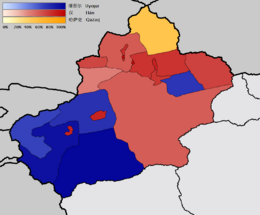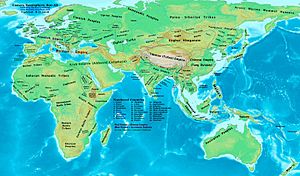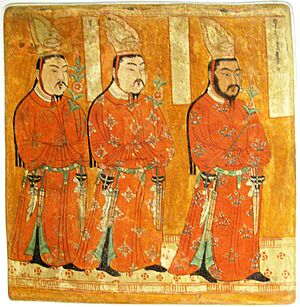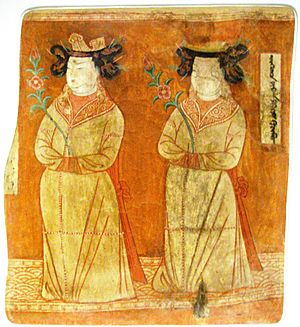History of the Uyghur people facts for kids
The history of the Uyghur people spans over 2,000 years. It can be divided into four main periods: the time before their empire (300 BC – AD 630), their own empire (AD 630–840), the Idiqut period (AD 840–1200), and the Mongol period (AD 1209–1600).
Uyghur history tells the story of a small nomadic group from the Altai Mountains. They often competed with other powerful groups in Central Asia. These included other nomadic tribes, empires from the south and west, and large empires to the east. After their empire, the Uyghur Khaganate, fell in AD 840, many ancient Uyghurs moved. They settled in the Tarim Basin and parts of northern China. Later, some Uyghurs even became important officials in the Mongol Empire.
Contents
- Understanding Uyghur History
- Early Uyghur History (Before AD 630)
- The Uyghur Khaganate (AD 744–840)
- Uyghur Kingdoms After the Empire
- The Kara-Khanid Khanate
- The Mongol Period (1210–1760)
- Qing Dynasty Control (1760s–1860s)
- The Yettishar State
- Xinjiang Under Qing Rule
- The Republican Era (1910–1949)
- From 1949 to Today
- See also
- Images for kids
Understanding Uyghur History
The history of the Uyghur people is very long and interesting. Modern Uyghurs believe they have lived in the Xinjiang region for thousands of years. They see themselves as the original people of this land. Some historians have found evidence that suggests a very long history for the Uyghur people.
After the Uyghur Khaganate fell in the 9th century, many Old Uyghurs moved from Mongolia. They mixed with other groups already living in the Tarim Basin. The modern Uyghur language is related to the languages spoken by the Kara-Khanid Khanate. The name "Uyghur" was later used again to describe many non-nomadic Turkic Muslims in Xinjiang.
Some Uyghur people believe they are related to the ancient Tocharians. Well-preserved Tarim mummies show that people with European features lived in the Tarim area around 2000 BCE. These people likely spoke Tocharian. Later, other groups from the west and northwest, like the Saka tribes, also moved into the Xinjiang area.
Early Uyghur History (Before AD 630)
Many historians believe that modern Uyghurs are related to the Tiele people. The Tiele were herders who lived near Lake Baikal and the Yenisei River. They first appeared in history around AD 357. The Chinese called them Gaoche because of their tall, ox-drawn carts. The Tiele were skilled metalworkers. This was because there was a lot of iron ore in the Yenisei River area.
The ancient Chinese book Book of Sui lists about forty Tiele tribes. These tribes were spread across North and Central Asia. One of these tribes was called Weihe, which was an early name for Uyghur.
In AD 546, the Tiele tribes fought against the Türk tribe. The Tiele lost and were forced to serve the Türk. This started a long rivalry between the Türk and Tiele groups. During this time, nine Tiele tribes formed a group called Tokuz-Oguzes (meaning "Nine-Tribes"). The Uyghurs were the leading tribe in this group.
In AD 600, the Sui Dynasty of China joined with the Uyghur leader, Erkin Tegin. They fought against the Göktürk Empire, which was their common enemy. Later, three tribes came under Uyghur control: Bugu, Tongra, and Bayirqu.
The Uyghurs continued to fight against the Göktürks. In AD 627, the Uyghurs, led by Pusa, joined another revolt against the Göktürks. In AD 630, the Göktürk Khanate was defeated by Tang Taizong of China. In AD 646, a Uyghur leader named Tumitu Ilteber was given a Chinese title. This helped establish the Uyghurs' right to rule.
From AD 648 to 657, the Uyghurs worked as soldiers for the Chinese. They helped China take over the Tarim Basin. In AD 683, the Uyghur tribe moved to the Selenga River valley. From there, they continued to fight against the Second Göktürk Empire.
By AD 688, the Göktürks again controlled the Uyghurs. But after several revolts with their Chinese allies, the Uyghurs became leaders of the Tokuz-Oguz and Tiele tribes once more. In AD 744, the Uyghurs, along with their allies, defeated the Göktürks. The next year, they founded the Uyghur Khaganate at Mount Ötüken. Controlling Mount Ötüken was a symbol of power over the Mongolian steppe.
The Uyghur Khaganate (AD 744–840)
The Uyghur Khaganate was a powerful empire that lasted from AD 744 to 840. Its capital city was Ordu-Baliq, which was one of the largest ancient cities in modern-day Mongolia. When the empire was founded, it controlled a large area. This included the entire territory of the ancient Xiongnu people. At its largest, the Khaganate reached as far west as Ferghana.
Many refugees from Sogdiana came to Ordu-Baliq. They were escaping the Islamic conquest of their homeland. These Sogdians helped change the Uyghur nobles from Buddhism to Manichaeism. The Uyghurs adopted many parts of Sogdian culture. Sogdians also helped manage the empire's government. They were important traders on the Silk Road. The Uyghurs learned from them and eventually took over their roles as traders and cultural leaders.
In AD 840, the Uyghur Khaganate faced a famine and civil war. It was then defeated by an alliance of Tang-dynasty China and the Kirghiz people. As a result, most of the Uyghur groups moved to what is now northwestern China. They settled especially in the Turfan basin of the modern Xinjiang Uyghur Autonomous Region.
Chinese forces under General Shi Xiong fought a big battle in 843. They defeated the Uyghur Khaganate soldiers. This helped destroy the Uyghur empire in Mongolia.
During the Tang dynasty, some rules were made to separate foreigners from Chinese people. For example, in 779, Uyghurs in the capital city had to wear their own traditional clothes. They were also stopped from marrying Chinese women.
Uyghur Kingdoms After the Empire
After the Uyghur Khaganate collapsed, the Uyghurs left Mongolia. They spread out into what is now Gansu and Xinjiang. They later formed two important kingdoms:
- Ganzhou Uyghur Kingdom: This kingdom was in the east (AD 870–1036). Its capital was near present-day Zhangye in Gansu province. Here, the Uyghurs changed their religion from Manichaeism to Tibetan and Mongol Buddhism. Unlike other Turkic groups further west, they did not become Muslim. Their descendants are known today as Yugurs. In AD 1028–1036, the Yugurs were defeated and taken over by the Tangut kingdom. They remained Buddhist.
- Kingdom of Qocho: This kingdom was formed around AD 856–866. It was also called the "Idiqut" state. Its main cities were Qocho (winter capital) near Turpan, Beshbalik (summer capital), Kumul, and Kucha. This was a Buddhist state, and it became a major center of Uyghur culture. The Uyghurs helped build many temple caves in the nearby Bezeklik. They also adopted a new writing system, which became known as the Uyghur script. The rulers of Qocho were called Idiquts. They ruled independently until they became a vassal state of the Kara-Khitans. In 1209, the ruler Idiqut Barchuq promised loyalty to Genghis Khan of the Mongols. The kingdom continued as a vassal state until 1335. After joining the Mongols, Uyghurs became important officials. They provided skills that the Mongols, who were initially not literate, needed. The Mongols gave the Uyghurs of Qocho a lot of freedom. However, their nation was eventually destroyed by the Chaghataid Mongols in the late 14th century.
The Kara-Khanid Khanate
Modern Uyghurs consider the Kara-Khanid Khanate a very important part of their history. The Kara-Khanids were a state formed by a group of Turkic tribes. Some historians believe they were connected to the Uyghurs of the Uyghur Khaganate.
The Kara-Khanid ruler, Sultan Satuq Bughra Khan, became a Muslim in 934. After this, many Kara-Khanids also converted to Islam in 960. The first capital of the Kara-Khanids was Balasagun. It later moved to Kashgar.
During the Kara-Khanid period, many mosques, schools, bridges, and inns for travelers were built in cities. Kashgar, Bukhara, and Samarkand became important centers for learning. Turkic literature also grew during this time. Important books from this period include Kutadgu Bilig ("The Knowledge That Gives Happiness") by Yusuf Balasaghuni. Another was Dīwān Lughāt al-Turk ("Compendium of the languages of the Turks") by Mahmud al-Kashgari. Mahmud al-Kashgari actually saw the Islamic Kara-Khanids as different from the Buddhist Uyghurs in Qocho.
The Kara-Khanid states later came under the rule of the Kara-Khitans. The Kara-Khitans defeated the Seljuks in a big battle. The Kara-Khanid states finally ended when they were divided between the Khwarezmids and Kuchlug.
Most Uyghurs in the Besh Balik and Turpan regions did not become Muslim until the 15th century. This was when the Yarkand Khanate, a Turko-Mongol state, expanded. Before becoming Muslim, Uyghurs followed religions like Tengriism, Manichaeism, Buddhism, or Nestorian Christianity.
The Mongol Period (1210–1760)
In 1209, the Uyghur Idiqut ruler, Barchukh, willingly joined Genghis Khan. He was even given Genghis Khan's daughter, Altani, to marry. From the 1260s, the Uyghurs were directly controlled by the Yuan dynasty of the Great Khagan Kublai. Starting in the 1270s, Mongol princes from Central Asia often raided Uyghur lands. They wanted to take control from the Yuan dynasty. Most Uyghurs, including their ruling family, moved to Gansu, which was under the Yuan dynasty.
Uyghur soldiers served in the Mongol armies across Central Asia, China, and the Middle East. Because they were a developed group under the Mongols, Uyghurs held important positions in the Mongol court. Tata-tunga was the first scribe for Genghis Khan. He helped create the Uyghur-Mongolian script that the Mongols used.
The Chagatai Khanate was a Mongol kingdom ruled by Chagatai Khan, the second son of Genghis Khan. Chagatai's territory stretched from the Ili River to Kashgaria and Transoxiana. The exact time when Turfan and other Uyghur areas came under the Chagatai Khanate is not clear. Many scholars believe Chagatai Khan inherited these lands from his father, Genghis Khan, in the early 13th century. By the 1330s, the Chagatayids fully controlled the Uyghur Kingdom in Turfan.
After the death of the Chagatayid ruler Qazan Khan in 1346, the Chagatai Khanate split into two parts: western (Transoxiana) and eastern (Moghulistan/Uyghuristan). By 1348, the Mongol khan, Tughlug Timur, became a Muslim, along with 160,000 of his people. A small Mongol kingdom, Qara Del, was founded in Hami in 1389, where Uyghurs also lived.
Moghulistan
The western part of the Chagatai Khanate was taken over by several tribal leaders. In the east, Tughlugh Timur (1347–1363) gained power over the nomadic Mongols and converted to Islam. He tried to reunite the khanate by invading the western half in 1360 and 1361. At their largest, the Chaghataite lands reached from the Irtysh River in Siberia to Ghazni in Afghanistan. They also stretched from Transoxiana to the Tarim Basin.
Tughlugh Timur could not fully control all the tribal rulers. After he died in 1363, the Mongols left Transoxiana. Tamerlane, a Muslim from Transoxiana, wanted to control the khanate. He took Samarkand in 1366 and became ruler in 1370. For over thirty years, Timur used the Chagatai lands as a base for many conquests. He conquered rulers in Afghanistan, Persia, Iraq, India, and Syria. Timur died in 1405 while marching towards Ming-dynasty China. His son, Shah Rukh, continued the Timurid dynasty until his death in 1447.
By 1369, Tamerlane had conquered the western part of the Chagatai Khanate. The eastern part, mostly in what is now Xinjiang, remained under Chagatai princes. These princes sometimes allied with or fought against Timurid princes. Until the 17th century, all remaining Chagatai lands came under the religious rule of the Uyghur leader Apak Khoja and his family, the Khojijans. They ruled Altishahr in the Tarim Basin.
Both the Tarim Basin and Transoxiana became known as Moghulistan. This was named after the ruling class of Chagatay and Timurid states. These rulers became Muslim and spoke Turkic languages. This ruling class later established the Mughal Empire in India.
In the eastern part of the Chagatai Khanate, the culture of the Kara-Khanids was strong. Most of the Buddhist people in the former Karakhoja Idikut-ate converted to Islam. All Chagatai-speaking Muslims were known by their jobs. These included Moghols (the ruling class), Sarts (merchants and townspeople), and Taranchis (farmers).
The Eastern Chagatai Khanate was often unstable and had many internal wars. Kashgar, Yarkant, and Qomul were major centers. Some Chagatay princes allied with the Timurids and Uzbeks. Others sought help from the Buddhist Kalmyks.
The Khojijans were a religious group. Struggles between two important Khojijan groups caused chaos in the Eastern Chagatai region in the late 17th century. Apaq Khoja became a powerful religious and political leader. The last ruling Chagatay princess married one of the Khojijan princes. She ruled very harshly after her husband died. She was known for killing many of her rivals. Despite her cruelty, the Khojijan dynasty fell into chaos.
During the Ming Turpan Border Wars, the Chinese Ming dynasty defeated invasions by the Uyghur Kingdom of Turpan. The invasion of the Manchu-led Qing dynasty brought their military rule to the Ili Valley. Khojijan princes fought against Qing rule until the Qing dynasty was overthrown.
Qing Dynasty Control (1760s–1860s)
The Qing dynasty conquered Moghulistan in the 18th century. They invaded Dzungaria in 1759 and ruled it until 1864. The area was renamed Xinjiang soon after the Qing took control. "Xinjiang" means "New Dominion" or "New Territory" in Chinese.
A large slave trade began in Xinjiang. The Uyghurs were managed by a system of local officials called begs. These begs were controlled by Manchu military officers.
Chinese people had to wear a queue (a braided ponytail) to show loyalty to the Qing dynasty. However, Turkic Muslims like the Uyghurs and Salars were not forced to do this. Later, after a rebellion led by Jahangir Khoja, Turkistani Muslim begs and officials in Xinjiang eagerly wanted to wear a queue. This was to show their strong loyalty to the Empire. High-ranking begs were given this right.
The Chinese did not always tell the difference between local Uyghurs and invaders. They killed Turks who tried to hide with Chinese citizens. Many Chinese and Chinese Muslims had been killed by Jahangir's forces. So, they wanted revenge. The Uyghur Muslim rebel, Jahangir Khoja, was executed in 1828 by the Manchus. This was for leading a rebellion against the Qing.
The Yettishar State
During the Dungan revolts of 1864, started by Hui Muslims, the Turkic Muslims also rebelled in several cities. These included Kashgar, Yarkand, Hotan, and Turpan. The Khoqandi leader, Yaqub Beg, then created the Yettishar state in the region in 1865. This state was recognized by the Ottoman Empire in 1873. However, Yaqub Beg's rule was not popular with the local people. This was because of his strict rules, high taxes, and declining trade.
Uyghur Muslim forces under Yaqub Beg declared a holy war against Chinese Muslims. The Uyghurs believed that Chinese Muslims belonged to a different Islamic school of thought. So, they felt they should fight them. Yaqub Beg even used non-Muslim Chinese soldiers to fight against the Chinese Muslims. Yaqub's forces defeated the Chinese Muslims in the Battle of Urumqi in 1870.
In the late 1870s, the Qing dynasty decided to reconquer Xinjiang. General Zuo Zongtang led this effort. He was joined by Muslim General Ma Anliang and his forces. Ma Anliang and his troops fought alongside Zuo Zongtang to defeat the Muslim rebels. On December 18, 1877, the Qing army entered Kashgar. This brought the Yettishar state to an end.
Xinjiang Under Qing Rule
After this invasion, the region was officially renamed "Xinjiang" by the Qing empire on November 18, 1884. This name means "New Dominion" or "New Territory."
During the Qing dynasty, the Uyghur people living in the oases around the Tarim Basin were mostly known as Taranchi and Sart. They spoke dialects related to Chagatay. They were ruled by the Moghuls of Khojijan. Other parts of the Islamic world still called this area Moghulistan.
The Republican Era (1910–1949)
During this time, Uyghurs often identified themselves by their oasis city. For example, they might call themselves 'Khotanese' or 'Kashgari'. In 1921, the Soviets met with Uyghurs and other Turkic leaders. This meeting led to the creation of the Revolutionary Uyghur Union. This was a communist nationalist group that worked secretly in cities in Kashgaria.
By the 1920s, Uyghur nationalism became a challenge to the Chinese warlord Yang Zengxin. A poet from Turpan, Abdulhaliq, returned to Xinjiang. He used "Uyghur" as his surname. He wrote a nationalist poem called Oyghan (meaning "Wake Up!"). It began with the line, "Hey poor Uyghur, wake up!" He was later killed in 1933 for encouraging Uyghur nationalist feelings.
There were different Uyghur groups during Yang's rule. Some Uyghurs were happy to live under Chinese rule. Others were against it.
Uyghur independence activists led several uprisings against Chinese rule. Twice, in 1933 and 1944, the Uyghurs briefly gained independence. The First East Turkestan Republic was a short-lived attempt at independence around Kashghar. It was defeated by the Chinese Muslim army in 1934. The Uyghurs had revolted with the Kirghiz people. They targeted Chinese Muslims and Han Chinese during their revolt.
The Second East Turkistan Republic existed from 1944 to 1949. It was located in what is now Ili Kazakh Autonomous Prefecture. The Ili Rebellion was fought against the Chinese Nationalist Party (Kuomintang) by the Second East Turkestan Republic, the Soviet Union, and Mongolia.
From 1949 to Today

In 1949, the Chinese Nationalists lost the civil war in China. The leaders of the Second East Turkestan Republic were invited to join Mao Zedong's People's Republic of China. However, many of the Republic's leaders died in a plane crash. The surviving leader, Saifuddin Azizi, joined the Chinese Communist Party. He promised loyalty to the PRC. Soon after, General Wang Zhen marched into East Turkestan. He put down uprisings against the invasion. Mao changed the Second East Turkistan Republic into the Ili Kazakh Autonomous Prefecture. He appointed Azizi as the region's first Communist Party governor. Many who supported the Republic fled to other countries like Turkey.
The name Xinjiang was changed to Xinjiang Uyghur Autonomous Region. Most Uyghurs live in southwestern Xinjiang.
In 2004, Uyghurs and other Turkic peoples living outside China formed the East Turkistan Government in Exile. They claim that China has occupied East Turkistan.
Reports from independent experts and international media have stated that many Uyghurs are being held in Xinjiang internment camps. Some reports suggest that millions of Uyghurs are in these camps. In 2018, the BBC published details of an investigation into these camps.
See also
- Uyghur Khaganate
- History of Mongolia
- Turkic migration
- History of Xinjiang
Images for kids






